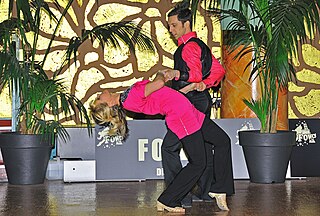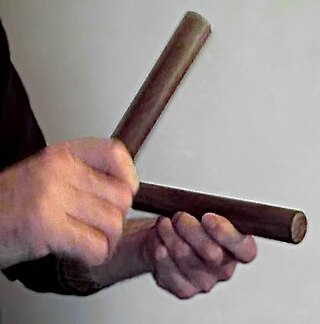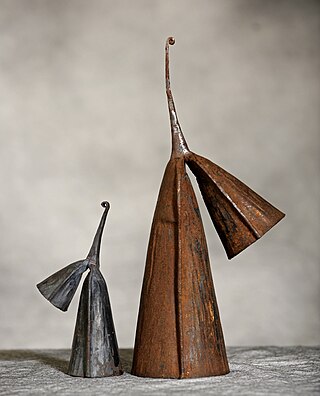Related Research Articles

Ballroom dance is a set of European partner dances, which are enjoyed both socially and competitively around the world, mostly because of its performance and entertainment aspects. Ballroom dancing is also widely enjoyed on stage, film, and television.

East Coast Swing (ECS) is a form of social partner dance. It belongs to the group of swing dances. It is danced under fast swing music, including: big band, rock and roll, rockabilly, and boogie-woogie.

West Coast Swing is a partner dance with roots in Lindy Hop, characterized by an elastic look that results from its extension-compression technique of partner connection and is danced primarily in a slotted area on the dance floor. The dance allows for both partners to improvise steps while dancing together, putting West Coast Swing in a short list of dances that emphasize improvisation.

Salsa is a Latin American dance, associated with salsa music. It originated in Eastern Cuba in the late 1940s and gained popularity in New York in 1960.

The clave is a rhythmic pattern used as a tool for temporal organization in Brazilian and Cuban music. In Spanish, clave literally means key, clef, code, or keystone. It is present in a variety of genres such as Abakuá music, rumba, conga, son, mambo, salsa, songo, timba and Afro-Cuban jazz. The five-stroke clave pattern represents the structural core of many Cuban rhythms. The study of rhythmic methodology, especially in the context of Afro-Cuban music, and how it influences the mood of a piece is known as clave theory.

Modern social round dance, or round dancing, is a choreographed and cued ballroom dance that progresses in a circular counter-clockwise pattern around the dance floor. The two major categories of ballroom dances found in round dancing are the smooth and international ballroom styles and the Latin dances. It is not to be confused with circle dancing, which is a type of folk dance in which dancers are connected in a circular chain.
This is a list of dance terms that are not names of dances or types of dances. See List of dances and List of dance style categories for those.
Rhumba, also known as ballroom rumba, is a genre of ballroom music and dance that appeared in the East Coast of the United States during the 1930s. It combined American big band music with Afro-Cuban rhythms, primarily the son cubano, but also conga and rumba. Although taking its name from the latter, ballroom rumba differs completely from Cuban rumba in both its music and its dance. Hence, authors prefer the Americanized spelling of the word (rhumba) to distinguish between them.

The quickstep is a light-hearted dance of the standard ballroom dances. The movement of the dance is fast and powerfully flowing and sprinkled with syncopations. The upbeat melodies that quickstep is danced to make it suitable for both formal and informal events. Its origins are in combination of slow foxtrot combined with the Charleston, a dance which was one of the precursors to what today is called swing dancing.
The Hustle is a catch-all name for some disco dances which were extremely popular in the 1970s. Late 1970s, Bump, Hustle, Watergate and Spank were popular. It mostly refers to the unique partner dance done in nightclubs to disco music. Hustle has steps in common with Mambo and Salsa and basic steps are somewhat similar to Euro dance style Discofox, which emerged at about the same time and is more familiar in various European countries. Modern partner hustle is sometimes referred to as New York hustle, however, its original name is the Latin hustle.

The cha-cha-cha is a dance of Cuban origin. It is danced to cha-cha-cha music introduced by the Cuban composer and violinist Enrique Jorrin in the early 1950s. This rhythm was developed from the danzón-mambo. The name of the dance is an onomatopoeia derived from the shuffling sound of the dancers' feet when they dance two consecutive quick steps that characterize the dance.
The country/western two-step, often called the Texas two-step or simply the two-step, is a country/western dance usually danced to country music in common time. "Traditional [Texas] two-step developed, my theory goes, because it is suited to fiddle and guitar music played two-four time with a firm beat [found in country music]. One-two, one-two, slide-shuffle. The two-step is related to the polka, the Texas waltz, and the jitterbug.
The Texas two-step is the same step known to ballroom dancers as the international fox-trot. Except for the one-step, which is just that, most Texas dances are variations of a two-step, also called a half-step, which is simply a step-close-step. The Texas two-step is generally done with two long steps and a step-close-step to two-four time. Speeded up, it's a shuffle or double shuffle, but still a two-step.
Triple metre is a musical metre characterized by a primary division of 3 beats to the bar, usually indicated by 3 (simple) or 9 (compound) in the upper figure of the time signature, with 3
4, 3
8 and 9
8 being the most common examples. In these signatures, beats form groups of three, establishing a triple meter feel in the music or song. The upper figure being divisible by three does not of itself indicate triple metre; for example, a time signature of 6
8 usually indicates compound duple metre, and similarly 12
8 usually indicates compound quadruple metre.
Arará is an African diasporic religion that developed in Cuba during the late 19th century. It is sometimes regarded as a distinct religion of its own, and at other times as a variant of Santería.
Lock step refers to any of several dance steps that involves the "locking" of the moving foot: the moving foot approaches to the standing foot, crosses in front of or behind it in the direction of the approach, stops close to the standing foot, and the weight is fully transferred to the (previously) moving foot.

Jazz drumming is the art of playing percussion in jazz styles ranging from 1910s-style Dixieland jazz to 1970s-era jazz fusion and 1980s-era Latin jazz. The techniques and instrumentation of this type of performance have evolved over several periods, influenced by jazz at large and the individual drummers within it. Stylistically, this aspect of performance was shaped by its starting place, New Orleans, as well as numerous other regions of the world, including other parts of the United States, the Caribbean, and Africa.

A bell pattern is a rhythmic pattern of striking a hand-held bell or other instrument of the idiophone family, to make it emit a sound at desired intervals. It is often a key pattern, in most cases it is a metal bell, such as an agogô, gankoqui, or cowbell, or a hollowed piece of wood, or wooden claves. In band music, bell patterns are also played on the metal shell of the timbales, and drum kit cymbals.
The Collegiate Shag is a partner dance done primarily to uptempo swing and pre-swing jazz music. It belongs to the swing family of American vernacular dances that arose in the 1920s and 30s. It is believed that the dance originated within the African American community of the Carolinas in the 1920s, later spreading across the United States during the 1930s. The shag is still danced today by swing dance enthusiasts worldwide.
Triple step, in music, represents a rhythmic pattern covering three dance steps done on music.
References
- ↑ Kassing, Gayle (2014-05-23). Discovering Dance. Human Kinetics. ISBN 978-1-4925-8454-4.
- ↑ Storey, Rita (2006). Line Dancing: And Other Folk Dances. Sea to Sea Publications. ISBN 978-1-59771-052-7. Archived from the original on 2024-05-30. Retrieved 2024-05-30.
- ↑ Kjelle, Marylou Morano (2020-05-11). Line Dances Around the World. Mitchell Lane. ISBN 978-1-5457-5143-5. Archived from the original on 2024-05-30. Retrieved 2024-05-30.
- ↑ Cupit, Scott (2015-09-17). Swing Dance: Fashion, music, culture and key moves. Jacqui Small. ISBN 978-1-910254-44-8. Archived from the original on 2024-05-30. Retrieved 2024-05-30.
- ↑ Daniel, Yvonne (2005). Dancing Wisdom: Embodied Knowledge in Haitian Vodou, Cuban Yoruba, and Bahian Candomblé. University of Illinois Press. ISBN 978-0-252-07207-9.